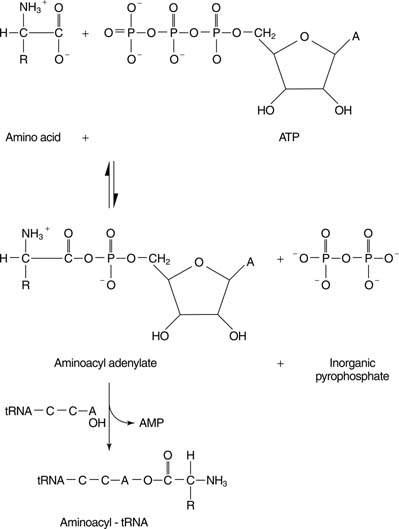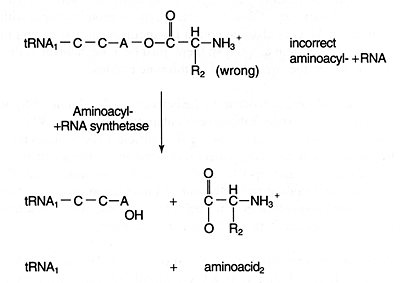Aminoacylation is a two-step process, catalyzed by a set of enzymes known asaminoacyl-tRNA synthetases. Twenty aminoacyl-tRNA synthetases reside in each cell, one per amino acid in the genetic code. In the first step of aminoacyl-tRNA synthesis, ATP and the appropriate amino acid form an aminoacyl adenylateintermediate. Inorganic pyrophosphate is released and subsequently broken down to free phosphate by the enzyme inorganic pyrophosphatase. The aminoacyl adenylate is a “high-energy” intermediate, and in the second step, the transfer of amino acids to the acceptor end of tRNA occurs without any further input of ATP, as shown in Figure 1 .
| |||
| |||
The aminoacyl-tRNA synthetase carries out an editing step to ensure against misacylated tRNA being used in protein synthesis. Because the ribosome must treat all aminoacyl-tRNAs as the same for making the peptide bond, any tRNA bearing the wrong amino acid would be used for protein synthesis, possibly causing the synthesis of a harmful protein. Editing aminoacyl-tRNAs for accuracy is carried out by a second active site on the aminoacyl-tRNA synthetase. (See Figure 2 .)
| |||
| |||
This function of the enzyme cleaves the incorrect aminoacyl- tRNA to yield free amino acid and tRNA. This process is analogous to the editing by the 3′-5′ exonucleolytic function of DNA polymerases that goes on during DNA synthesis. Like that process, aminoacyl-tRNA editing causes a “futile cycle” in which the enzyme synthesizes a bond by using energy and then breaks it down. In both cases, the fidelity of information processing is preserved at the expense of energy “wastage.” Mistakes are so dangerous to the cell that the expenditure is a good bargain.


0 comments:
Post a Comment